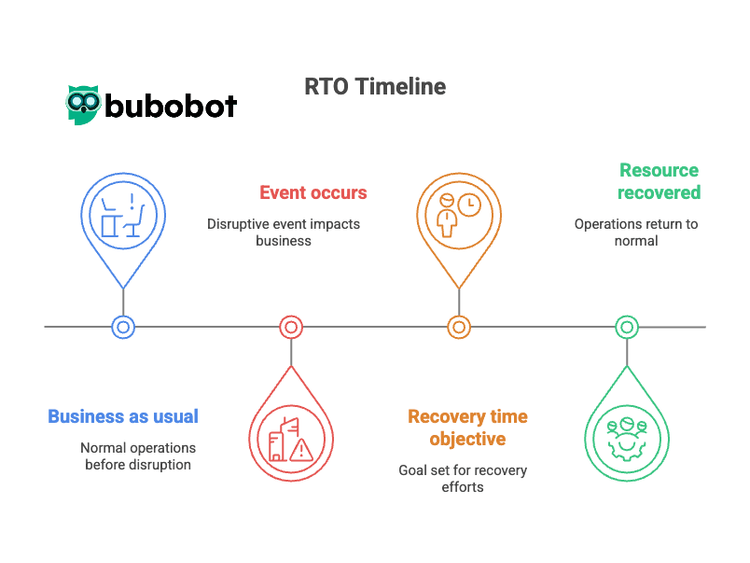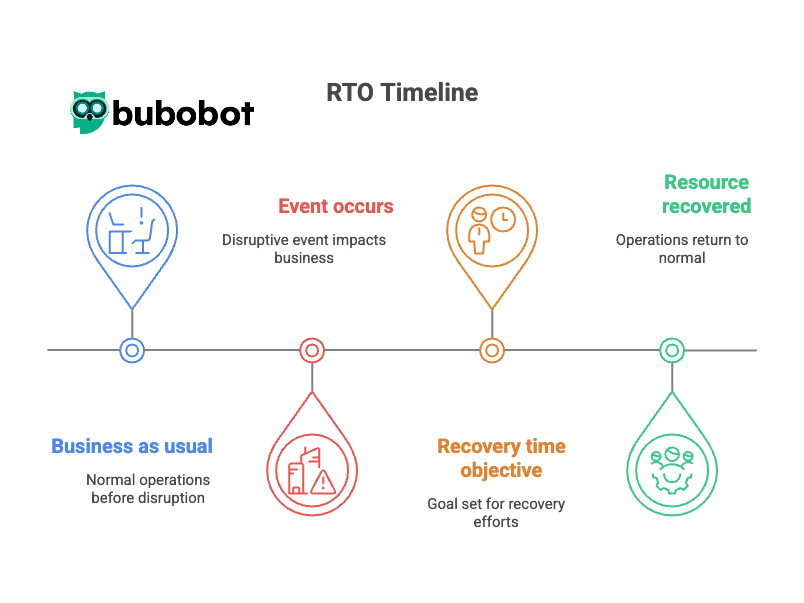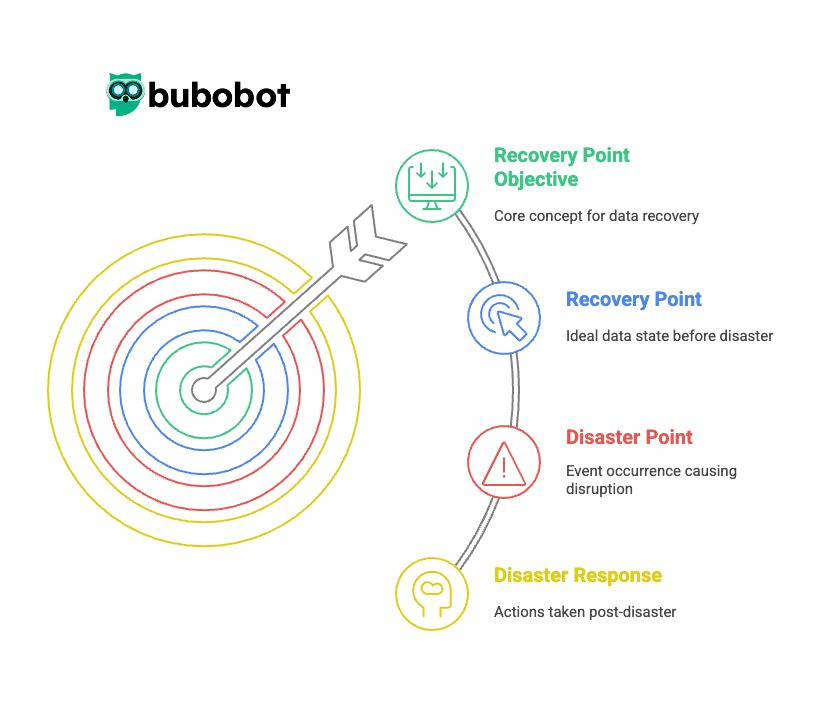RTO vs. RPO: Understanding the Difference and Their Impact on Disaster Recovery

1. Introduction
When systems go down, every second counts. Recovery planning isn't just another checkbox—it keeps your services running when things go wrong. Modern infrastructures are complex, and without clear recovery targets, you're flying blind during an outage.
DevOps teams need RTO and RPO metrics because they turn abstract "disaster recovery" concepts into measurable goals. But here's the thing: these aren't just numbers you set and forget. They're your guardrails for building robust business continuity plans.
2. Understanding RTO (Recovery Time Objective): Ensuring Service Continuity

The RTO can be measured in seconds, minutes, hours or days.
Picture this: your critical system just went down. RTO answers one simple question: how long can your business survive without it? It's your maximum acceptable downtime, period.
The business impact is straightforward—every minute of downtime has a cost. For an e-commerce platform, it's lost sales. For a financial system, it's delayed transactions. Your SLAs aren't just commitments to customers; they're the backbone of your RTO planning.
Real-time monitoring makes or breaks your RTO goals. Without constant system health checks, you're just guessing at recovery times. Take a major cloud provider who reduced their recovery time from hours to minutes by implementing automated health checks and failover systems.
Want to implement effective RTO? Start by mapping your critical services. Set up monitoring at every crucial point. Test your recovery procedures—not just once, but regularly. And make sure your team knows exactly what to do when alerts fire.
3. Understanding RPO (Recovery Point Objective): Safeguarding Data Integrity

RPO is different—it's about data, not time. How much data can you afford to lose? For some systems, losing an hour's worth of data is fine. For others, even a minute's worth is catastrophic.
Think of RPO as your backup strategy's north star. It dictates how often you need to backup, what type of backup solutions you need, and how much you'll spend on data protection.
Continuous monitoring plays a crucial role here too. But instead of watching system availability, you're tracking data replication, backup success rates, and storage metrics. A healthcare provider we worked with used real-time backup monitoring to cut their potential data loss from hours to seconds.
To nail your RPO implementation, inventory your data assets. Set different RPO levels based on data criticality. Automate your backup processes. Most importantly, verify your backups actually work.
4. RTO vs. RPO: Key Differences and Their Impact on Recovery Planning

RTO is the target period of time for downtime in the event of IT downtime while RPO is the maximum length of time from the last data restoration point
Time vs. data—that's the fundamental difference. RTO focuses on getting systems back online. RPO focuses on saving your data. Both matter, but they drive different decisions.
Let's break down the key differences and their impact:
| Aspect | RTO | RPO | Impact on Planning |
|---|---|---|---|
| Focus | System Availability | Data Protection | Shapes recovery prioritization |
| Measurement | Time to Recovery | Acceptable Data Loss | Influences backup strategies |
| Cost Driver | Recovery Speed | Backup Frequency | Affects budget allocation |
| Technical Needs | Failover Systems | Backup Infrastructure | Determines architecture choices |
| Monitoring Requirements | Uptime Tracking | Backup Status | Guides monitoring setup |
Recovery workflows need both perspectives. Your RTO might be 4 hours, but if your RPO requires constant data syncing, you'll need a more sophisticated infrastructure. Resource allocation becomes a balancing act between quick recovery and data protection.
5. Best Practices for Optimizing RPO and RTO
Optimizing your recovery objectives isn't a one-time task. Here's what actually works in production environments:
Frequent Backups
Don't just rely on daily backups. Modern systems need tiered backup strategies. Critical databases might need real-time replication, while static content can handle longer backup intervals. Smart backup scheduling helps you meet RPO targets without overloading your infrastructure.
Redundancy and Failover
Build redundancy at every critical point. Your primary systems should have hot standbys ready to take over. But here's what many miss: your monitoring systems need redundancy too. If your monitoring goes down during an incident, you're flying blind.
Testing & Validation
Regular testing isn't optional. Schedule recovery drills quarterly at minimum. Run them under real-world conditions—during peak loads, with partial team availability. Document what works and what breaks. Each test should teach you something new about your recovery process.
Priority Based Recovery
Not all systems need the same recovery speed. Map out your service dependencies. Know which systems to bring up first. A common mistake is treating all services equally—they're not. Your authentication system probably needs to come up before your analytics pipeline.
Automation
Manual recovery procedures are too slow and error-prone for modern SLAs. Automate your recovery workflows. Build self-healing capabilities into your infrastructure. Use infrastructure as code to ensure your recovery environment matches production.
Ongoing Monitoring and Analytics
Real-time monitoring is your early warning system. Track performance metrics, error rates, and system health. Use predictive analytics to spot potential failures before they happen. Good monitoring helps you prevent outages, not just recover from them.
The key to success? Integration. These practices work best when they work together. Your monitoring should trigger automated recovery procedures. Your testing should validate your priority lists. Your automation should respect your backup schedules.
6. Conclusion
RTO and RPO aren't just technical metrics—they're your roadmap for surviving outages. The key is understanding their differences and how they work together.
Ready to strengthen your recovery planning? Start by:
- Clearly defining your RTO and RPO targets
- Setting up heartbeat monitoring for your backup processes
- Implementing comprehensive system health checks
- Testing your recovery procedures regularly
Modern monitoring solutions are essential for meeting both objectives. Tools like Bubobot offer the comprehensive monitoring you need—from HTTP endpoints to server health, Kafka availability to MQTT systems. This end-to-end visibility lets you track system health in real-time and act fast when issues arise.
Remember—these aren't set-and-forget metrics. They need to evolve as your business does. With the right monitoring strategy and tools in place, you can maintain high availability while meeting your recovery objectives.
Looking ahead, predictive monitoring and automated recovery systems are changing the game. But the fundamentals of RTO and RPO will always matter—because in the end, it's about keeping your business running, no matter what. Having a reliable monitoring platform that covers all your critical systems is the first step toward meeting your recovery objectives.
#RTOvsRPO #BusinessContinuity #UptimeRecovery